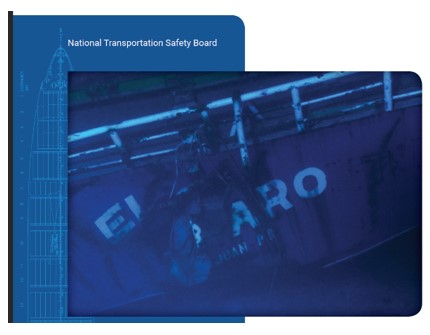NTSB: The sinking of the El Faro – an illustrated digest
What happened
The National Transportation Safety Board of the United States (NTSB) has published an illustrated digest of its own Marine Accident Report NTSB/MAR-17/01 into the loss of the cargo vessel El Faro.
The El Faro sank with the loss with all hands in a hurricane in 2015. The digest contains a description of the accident and safety issues, and summarizes some of the safety recommendations intended to prevent such an accident from happening again. It is an informative and worthwhile short read for all persons involved in ships and in the maritime and offshore world. One of the causal factors in the loss of the vessel (loss of lubrication oil to the main engine) is dealt with in IMCA Safety Flash 12-18 and here on the IMCA web page.

What went wrong
The NTSB outlined the following safety issues:
- The master’s actions – from early in the voyage, the captain made decisions that put his vessel and crew at risk;
- The use of old or not up-to-date weather information;
- A late decision to muster the crew. This was left late – too late;
- Ineffective bridge resource management – the bridge crew deferred to the captain’s authority and experience, rather than acting more assertively. When the crew did voice concerns, the captain chose not to listen;
- Inadequate company oversight;
- Failures in the company’s safety management system;
- Flooding in cargo holds;
- Loss of propulsion;
- Downflooding through ventilation closures.
Lessons learned
The NTSB’s general recommendations included:
- Better and wider dissemination of information relating to weather at sea;
- Engines and other critical machinery that work at greater angles of inclination (i.e., despite more listing);
- Enclosed, not open, lifeboats, that can be launched at still greater angles of inclination;
- Protected seawater supply piping in cargo holds;
- Remote open/close indicators for watertight doors and hatches;
- Guidance that actions intended to correct a list can be dangerous if cargo is adrift;
- Class-approved damage control plans/booklets onboard all vessels, regardless of build date;
- Review of the inspection program and improved oversight for vessel inspections;
- Lifesaving appliances updated at least every 20 years;
- Personal locator beacons for crewmembers;
- Improvements to Voyage Data Recorders (VDRs);
- Improved Bridge Resource Management (non-technical skills) training – and improved meteorology training – for deck officers.
About 3 minutes after El Faro’s VDR stopped recording, a reconnaissance aircraft estimated a 10-second average surface wind speed of 117 knots about 21 nautical miles south of El Faro’s last known position. At 0800, Hurricane Joaquin’s centre was estimated to be about 22 nautical miles south-southeast of El Faro’s last known position, according to an NHC post-storm assessment.
Safety Event
Published: 28 October 2021
Download: IMCA SF 29/21
IMCA Safety Flashes
Submit a Report
IMCA Safety Flashes summarise key safety matters and incidents, allowing lessons to be more easily learnt for the benefit of all. The effectiveness of the IMCA Safety Flash system depends on Members sharing information and so avoiding repeat incidents. Please consider adding [email protected] to your internal distribution list for safety alerts or manually submitting information on incidents you consider may be relevant. All information is anonymised or sanitised, as appropriate.
IMCA’s store terms and conditions (https://www.imca-int.com/legal-notices/terms/) apply to all downloads from IMCA’s website, including this document.
IMCA makes every effort to ensure the accuracy and reliability of the data contained in the documents it publishes, but IMCA shall not be liable for any guidance and/or recommendation and/or statement herein contained. The information contained in this document does not fulfil or replace any individual’s or Member's legal, regulatory or other duties or obligations in respect of their operations. Individuals and Members remain solely responsible for the safe, lawful and proper conduct of their operations.
